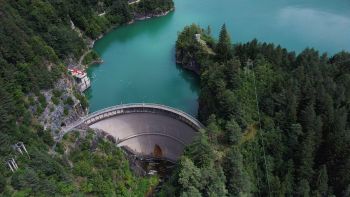Remotely Operated Vehicle Inspection

|
| Drone photograph of Stramentizzo Dam, Italy.
(Image Source: Wikimedia) |
Remote dam vehicle inspections utilize advanced technologies to assess the condition of dams without the need for physical presence on-site. These inspections are especially valuable in situations where access to the dam is challenging or when there are safety concerns for inspectors.
A key part of remote dam vehicle inspections are unmanned aerial vehicles (UAVs). These drones can be equipped with high-resolution cameras, thermal imaging sensors, LiDAR systems, and other specialized equipment to capture detailed visual data of the dam and its surrounding areas. Gathering data in this way helps dam officials collect information on the structural integrity, erosion patterns, vegetation growth, and other potential issues that may affect the dam's stability.
During a remote dam vehicle inspection, a trained operator remotely controls the drone, maneuvering it around the dam to capture visual and thermal images from various angles and altitudes. The collected data is then transmitted in real-time to a control station, where inspectors can view the footage and analyze it for potential concerns.
Data obtained from drone inspections allows inspectors to identify cracks, seepage, deformation, or settlements, in the dam structure. The thermal imaging sensors can detect temperature variations, highlighting potential areas of leakage, which can indicate weaknesses in the dam's integrity. LiDAR systems can be mounted on drones, utilizing laser scanning technology to create detailed 3D maps of the dam and its surroundings. This data provides accurate measurements of the dam and allows inspectors to assess the topography, identify erosion patterns, and detect any structural deformations. In addition to drones, remote dam vehicle inspections may also involve the use of remotely operated underwater vehicles (ROVs) to inspect the submerged portions of a dam without the need for divers or physical access.
Remote dam vehicle inspections offer several advantages over traditional on-site inspections including eliminating the need for physical access to remote or hazardous areas and reducing safety risks for inspectors. Remote inspections are also more cost effective, as they require fewer resources and can be conducted more efficiently.
However, it's important to note that remote dam vehicle inspections have some limitations that in-person inspections do not have. Their operation depends on weather conditions, as adverse weather can restrict drone operations. Additionally, while drones can capture detailed visual and thermal imagery, they cannot directly assess certain factors such as the internal condition of the dam or the strength of its materials.
In conclusion, remote dam vehicle inspections utilize technologies such as drones and ROVs to assess the condition of dams without the need for physical presence on-site. These inspections provide timely and detailed information to dam safety professionals, enabling them to monitor dam integrity, detect potential issues, and take appropriate actions to ensure the safety and reliability of dams.
